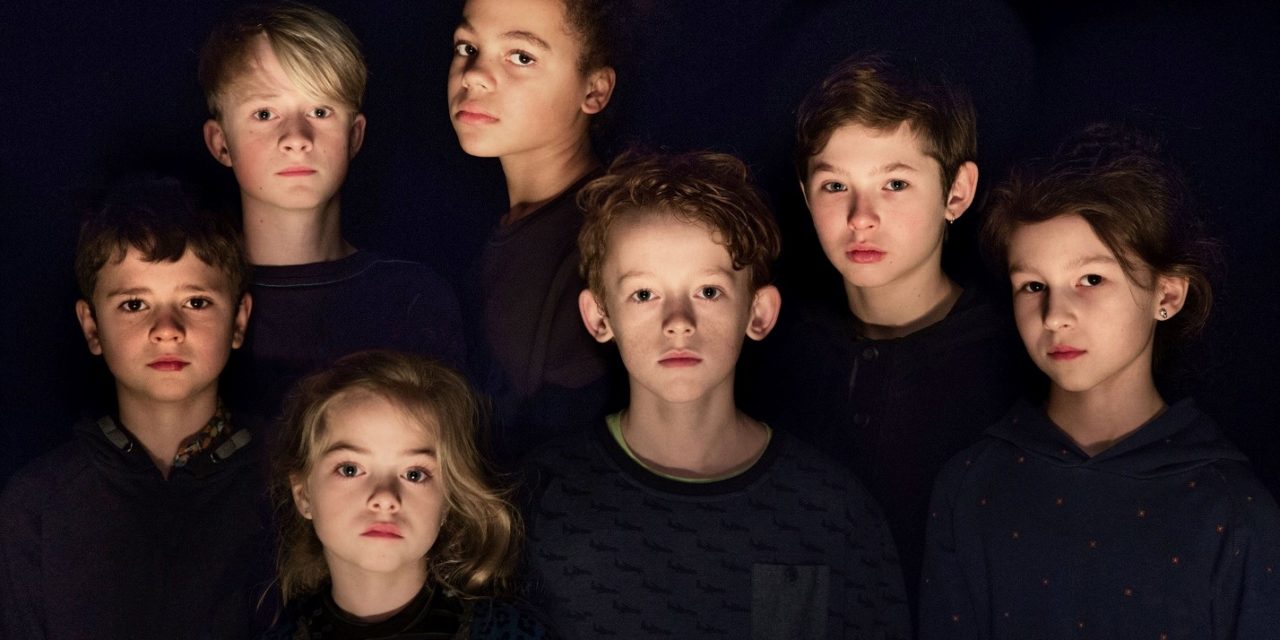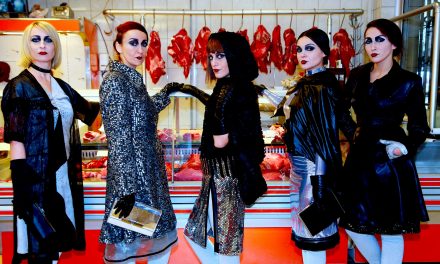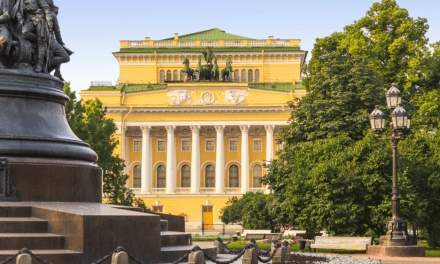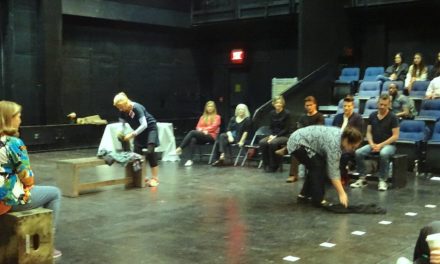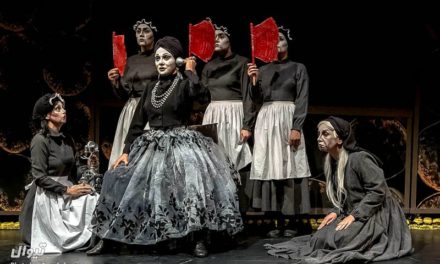The re-enactments are a way to examine and reproduce human feelings.
—Milo Rau [1]
This summer, as I was about to embark on initiating my fifth divisive performance with children and teenagers, the question about the ethics of engaging them in theatre for adults reintroduced a well-known fever and dilemma. The use of youngsters is a silver bullet that most of us get hit by; the effect is similar to using music to glorify a dramatic moment which may otherwise be too weak to stand on its own: it cracks our hearts open, and our cold, conscious judgment is mesmerized by the strong effect of our instinctive emotional reaction.
My first experience of working with young people was with those deported from Germany to Kosova upon their not being granted residency permits. In collaboration with Die Stelzer Theatre from Munich, we created a sci-fi fairy tale called Searching For Fantomia And The Desolate Mamumian, performed on high stilts. The piece was socially engaged, performed in a public space, and built during an intensive theatre workshop with the goal of helping participants transition more easily between places/countries, a situation which was causing them an identity crisis. We took their stories but gave them the ability to walk and dance on tall stilts, a metaphor for standing on unknown ground with new legs and feet.
The two latest theatre pieces I worked on, The Unstepped Forest In The Island Of Tam Tum and Veil, were developed with around 100 youngsters ages 3 to 18 of the Ashkali and Albanian community during a theatre summer camp last year and this year at the Loyola Gymnasium in Prizren, with a focus on deconstructing the stigma against the Roma community in Kosova and giving voice to their stories. Again, site-specific work.
The commonalities between these divisive theatre pieces lie in their work-in-progress nature, which aims to teach theatre-making to younger generations, help them acknowledge the power of theatre as a tool to express social issues, and mainly empower them to believe in changes that can derive from their initiative within a group.
In 2007, the acclaimed Swiss theatre-maker Milo Rau founded a theatre and film production company, the International Institute of Political Murder (IIPM), which over time developed into an institution focused on documenting notable historical global events and socio-political conflicts through the mediums of film, literature, documentaries, and research papers.
I had seen the recording of one of his first productions, The Last Hours Of Elena And Nicolae CeauŞescu, a re-enactment of the Ceauşescus’ trial. I was thrilled by the obscurity that the performance carried and the contradictory reactions it caused among the audience. Let me point out that the viewers were all coming from the theatre scene and were guests at the strikingly memorable international theatre meeting held in Prishtina in 2011 called PLAYGrounds: Between Facts And Fiction. Some had irritably perceived the re-enactment as a form of showing sympathy for the detained dictator and his wife, while others saw it as a basis for initiating debate about punishing the individual authority via the death penalty while the verdict comes from his own cabinet, which, to this day, continues to be in power…
All of Rau’s work is astoundingly interesting and grounded because it refers to existing realities that few have the guts to dig down to discover their own involvement, be it passive or active. Hence the re-enactments.
To illustrate, I’d like to point out his ground-breaking The Congo Tribunal, a multimediatic virtual reality representation turned into a documentary film which stages a trial of both parties involved in the terrifying civil war in Congo, including the Western involvement. Besides having had the magnitude of indicting the Congolese government and forcing two ministers to resign, the project questions the meaning of the wealth of the First World. As rightfully depicted by the German press Die Zeit, “Where politics fails, art can come to help.”
I had the honor of being a scholar at Theatertreffen’s International Forum in Berlin last year, a time during which I got introduced to many leading theatrical voices in Germany and from within the German-speaking territory, including Milo Rau. This is where I saw Five Easy Pieces, and it has stayed with me throughout this time, particularly because of similarities I found in this theatrical work with my own productions.
Once Tzvetan Todorov’s student and acclaimed as “Europe’s most exciting artist,” the documentary-theater director Milo Rau was invited by the CAMPO arts centre in Ghent to produce its biannual children’s play. Known for his unconventional approach to theatre, Rau began his journey by asking “what is the most memorable collective myth that unifies the Belgians?” a multi-ethnic society deprived of a consolidated national history. During rehearsals for his Belgium-related The Civil Wars in 2014, he surprisingly found out that the amalgam of the Belgians is the “White March” in 1996, a demonstration in Brussels, initiated after the serial child molester and killer Marc Dutroux was arrested.
How does one draw a parallel between colonialism, pedophilia, and a theatre director’s thrust to dictate?
Seven amateur actors ages 8 to 13 perform five (not so easy as the title suggests) scenes and monologues that offer an exposé of the Dutroux affair, from the perspectives of the victims, the victims’ parents, the investigators and Dutroux’s father, but never from the perpetrator’s point of view. They are interrogated in front of a camera operated by the only adult actor on the set, Peter Seynaeve, and this interrogation is livestreamed on the screen. The children also mimic pre-recorded scenes simultaneously on stage, within their capacity to interpret adult emotions such as shame, grief, fear, loss, and so forth. Ironically provocative for adults is an interview question that Seynaeve poses during his casting of the young actors, asking them what the perfect way to die is, during which the children coldly speak about falling from their bike and breaking their neck, for example.
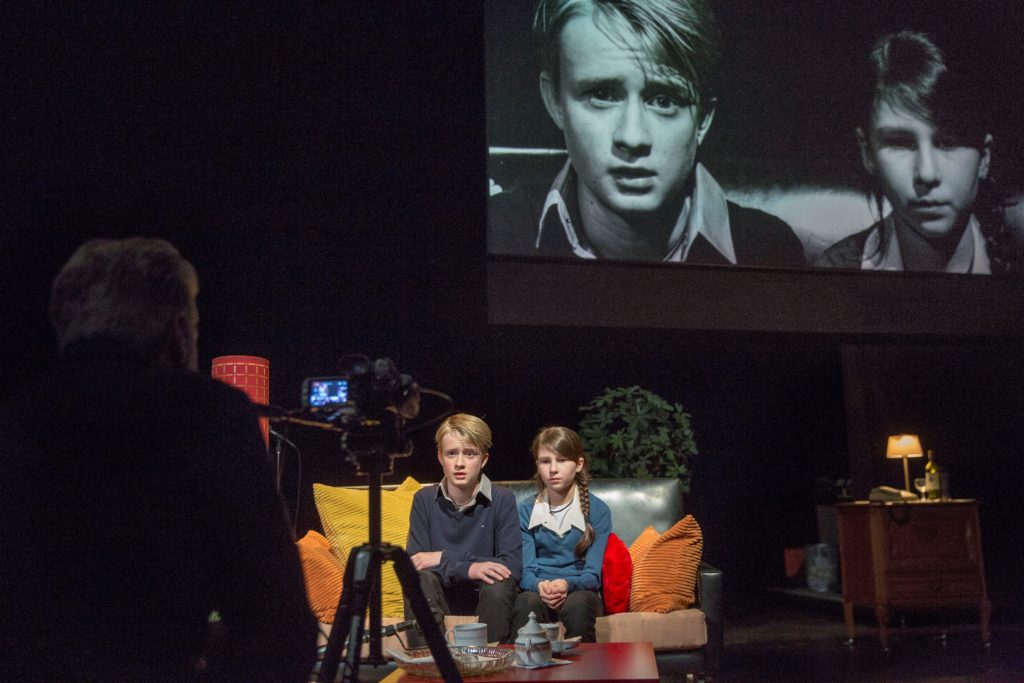
Five Easy Pieces Photo copyright Phile Deprez
Although it involves children, the play is clearly too complex, and it is dedicated to adults. The main target of criticism by those softer at heart is the ethical aspect of having children perform the dark edges of a deformed adult world. Are children able to understand adults’ feelings, and how does a childhood swiped away by political powers and appetites produce a social monster such as Dutroux? In many interviews, Rau firmly expresses his belief that there is a clear line between childhood and adulthood where the meaning of complex feelings is unable to cross:
We wanted to show something which people don’t want to see from children. Five Easy Pieces had to be a children’s theatre performance which was risky, unprecedented and virtually impossible. [2]
For the Belgian audience it is interesting because it stages a part of the national history of the country. At the same time it raises universal questions: how can we reproduce feelings that occur during such tragic events? And how can we overcome that trauma? [3]
Similar to his previous projects, with Five Easy Pieces Rau uses his performance as a base for analyzing theatre as a dynamic format within which power structures shift amidst the director and the actors. He draws connections between directing and violating children and tries to criticize representation. He thinks that the children’s lack of ability to understand what they are performing in this play saves the audience from the very dangerous utopian identification.
Ultimately, he questions the position of “the director,” the epitome of the eel-like fluidity of the unconsciously rooted dictate, the inevitable explosion of authoritarianism as embedded in us deeply through history and culture. This can be seen as his ability to reflect about his own work methods and the readiness to learn and grow from his own experiences.
At the same time, as stated by Rau himself, the play raises universal questions related to the human condition: how do we react to the re-enactment of such horrendous acts as pedophilia, and how responsible do we feel about this, although we are not directly involved? Rau draws a lineage between Belgium’s colonial past in Congo, where Dutroux grew up, and today’s clashes between the corrupt elites among the Flemish and the Walloons, which have caused an industrial deterioration in the country. It gives you shivers down the spine to know that Dutroux actually built his interrogation dungeons in this very industrial suburb of Brussels and that this wasn’t noticed by the state apparatus, namely the justice system and the police. Crime has been pushed to the periphery of the city in the same way that Dutroux becomes the encompassing object of evil and everyone points a finger at him, in order to avoid the difficult process of dealing with the past and themselves.
Milo Rau creates an audience that responds very strongly, although from the dark silence. Through having youngsters enact adults’ deformities, the piece sheds light on social constructions that shape our ways of thinking. The debate after the show was quite fired up, with two extreme boards of thought adrift: one despising the “misuse” of children by nakedly introducing them to a major trauma which is child kidnapping, rape, and murder, and the other applauding the courage of the stage language used to capture many layers of social extensions with a focused lens on the source and the cause: children and childhood. Hence, in the play, Marc Dutroux is objectively discussed but never present.
At the artist talk the day after we watched the show, the dramaturg Stefan Bläske and Peter Seynaeve, who also is the assistant director and the performance coach in the piece, were explaining that the decision about how far to go with the experiment of building a terrifyingly serious topic using children as deliverers was done in the presence and with agreement of their parents and a child psychologist as well as through the very friendly relationship that Rau built with his young actors. It seems, though, that the susceptibility of children is being questioned through the distancing moments in the play during which “the director” gives directions to the kids regarding acting as if this were a rigorous audition while filming them upfront in an almost porn-like, exposing atmosphere. The audience can sneakily grasp a glimpse of laughter between Seynaeve and the young actors, a moment that confirms the healthy connection between the kids and the adult crew.
What strikes me more than everything as an outcome is the controversy that theatre allegedly imposes on its creators and receptors and how this distinction has immersively melted since postmodernism. In fact, this may be the main evolutionary mechanism that theatre has embraced in order to survive in the era of mass media. Theatre generally remains an elitist form of social activism, although probably it is one of the most socio-politically engaged forms of art which has metamorphosed because of the necessity of time.
Milo Rau’s latest piece is called Familie and it is included in the 2019-2020 season at NTGent, where he serves as an Artistic Director. It is again centered around a crime against children. There have been several cases in which parents found themselves in emotional darkness and killed their own children after a split-up, and this is his starting point towards digging deeper into the darker pits of humanity by using a family of actors.

Five Easy Pieces Photo copyright Phile Deprez
Notes:
- Milo Rau interview with Dina Doorman,
https://planning.campo.nu/files/Producties/FiveEasyPieces/htf17_dagkrant_3108_def_five-easy-pieces.pdf, p. 2. - Milo Rau interview with Stefan Bläske,
http://www.augustinpr.de/tl_files/AugustinPR_Theme/Dokumente/20160414_Press-kit_Five-Easy-Pieces.pdf, p. 8. - Rau interview with Doorman, p. 2.
This post was written by the author in their personal capacity.The opinions expressed in this article are the author’s own and do not reflect the view of The Theatre Times, their staff or collaborators.
This post was written by Fjolla Hoxha.
The views expressed here belong to the author and do not necessarily reflect our views and opinions.

